Rail-ly fun rides: Your comprehensive guide to 11 JR East Joyful Trains!
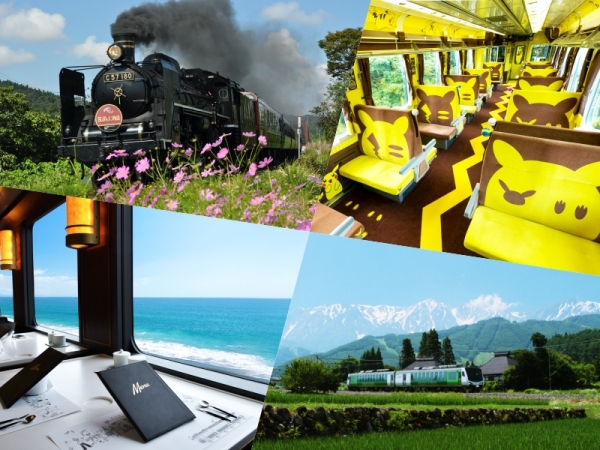
Updated as of 17 October 2023
Originally published on 07 August 2020
Japan may be synonymous with shinkansen (新幹線 bullet trains)—high-speed and high-tech—but local lines traversing the countryside also offer unforgettable travel experiences. In the Eastern Japan area, JR East’s Joyful Trains (のってたのしい列車 Nottetanoshii Ressha) were created for that purpose, to bring you on a fun-filled train ride while discovering local gems along the route!
Not just a means of transportation, each Joyful Trains has its own unique features, and can be split into four categories based on these features:
- Trains with unique interiors and on-board activities
- Scenic trains with fun station activities
- Steam locomotive (SL) trains
- Restaurants trains (with scenic views)
Which ones would you be interested in taking a trip on? Most of them are free to ride with a JR EAST PASS, so why not hop on for a fun ride the next time you are in Japan? Read on to find out more about each train!
Trains with unique interiors and on-board activities

Enjoy one-of-a-kind interiors on-board these Joyful Trains. (Image credit: JR East / Carissa Loh)
While you might not be able to tell just from looking at the train’s exterior, the interiors of these trains have been painstakingly decorated with one-of-a-kind installations, built around a distinctive theme.
With special features like domed planetariums, or meticulously decorated interiors, on-board musical performances, and events like sake-tasting, you might even have a hard time believing that you are on a train!
① POKÉMON with YOU Train: Pikachus galore
Route: Ichinoseki Station (一ノ関駅) ↔ Kesennuma Station (気仙沼駅) on the Ōfunato Line

Cute Pikachus await you on the POKÉMON with YOU Train. (Image credit: JR East / Carissa Loh)
Pika-pika! Fans of the adorable yellow Pikachu wouldn’t want to miss a ride on this POKÉMON with YOU Train. Started in 2012 to bring back smiles to children in the area affected by the 2011 Great Eastern Japan Earthquake and Tsunami (東日本大震災 Higashi-nihon daishinsai), this train got a revamp in 2017 to become its current cheerful Pikachu design.

Inside the delightful POKÉMON with YOU Train. (Image credit: JR East / Carissa Loh)
Hundreds of bright and cheery Pikachus adorn the exterior and interior of the train, bringing joy to children and adults alike. Kawaii Pikachu silhouettes and footprints can be found on the seats and floors of the seating car, while dozens of Pikachu plushies await you in the playroom.
Read this article for an in-depth, personal experience of a trip on the POKÉMON with YOU Train.
For more information, check the train’s website here.
② Koshino Shu*Kura: A train for sake lovers
Routes:
- Koshino Shu*Kura: Jо̄etsumyо̄kо̄ Station (上越妙高駅) ↔ Tо̄kamachi Station (十日町駅)
- Yuzawa Shu*Kura: Jо̄etsumyо̄kо̄ Station (上越妙高駅) ↔ Echigo-Yuzawa Station (越後湯沢駅)
- Ryuto Shu*Kura: Jо̄etsumyо̄kо̄ Station (上越妙高駅) ↔ Niigata Station (新潟駅)

The Koshino Shu*Kura was made for sake-lovers. (Image credit: JR East / Carissa Loh)
Sake-lovers can’t miss out on the Koshino Shu*Kura (越乃Shu*Kura), a train beloved by many local sake aficionados. Running in Niigata Prefecture, which is famed for rice and rice products like rice wine (酒 sake), the Koshino Shu*Kura has an interior which is meant to resemble casks at a sake brewery.

Fun with sake on-board the Koshino Shu*Kura. (Image credit: JR East / Carissa Loh)
This event space may feature special events such as live jazz performances, sake tasting sessions and more.. The bar counter is stocked with a variety of locally-produced sake, which change with the seasons.
Niigata Prefecture has the largest number of sake breweries in Japan, and some breweries are even within walking distance of the stations which the Koshino Shu*Kura’s stops at. Combine a ride on this train with a visit to a brewery, or sample a variety of local sake the Ponshukan (ぽんしゅ館) at Nagaoka Station!
Read this article for an in-depth, personal experience of a trip on the Koshino Shu*Kura.
For more information, check the train’s website here.
③ HIGH RAIL 1375: The train closest to the heavens
Route: Kobuchizawa Station (小淵沢駅) ↔ Komoro Station (小諸駅) on the Koumi Line

The HIGH RAIL 1375 passes by mountains and highland regions. (Image credit: JR East)
Passing through the highest elevation of railway tracks in Japan (1375m), the HIGH RAIL 1375’s concept is “the train closest to the heavens”. Window-facing seats let you get better views of the splendid Yatsugatake Mountain Range and other highland scenery.

Inside the HIGH RAIL 1375. (Image credit: JR East / Carissa Loh)
Astronomy fans will be delighted with the on-board domed planetarium (a first for a train) and mini astronomy library. If you take the evening train, the train will stop at Nobeyama Station (野辺山駅) for a free 1-hour stargazing tour.
Read this article for an in-depth, personal experience of a trip on the HIGH RAIL 1375.
For more information, check the train’s website here.
Scenic trains with fun station activities

Joyful Trains passing by scenic mountain and ocean views. (Image credit: JR East)
These Joyful Trains traverse routes with beautiful scenery, offering stunning views along the way. At scenic spots along the route, some trains slow down for you to take photos from the large windows, or you can get off at the station to get a closer look, or there are buses to bring you to the places of interest.
④Resort Shirakami: The pioneer Joyful Train
Route: Akita Station (秋田駅) ↔ Aomori Station (青森駅) on the Gonō Line
(Some trains terminate at Hirosaki Station (弘前駅) instead of Aomori Station)

The three Resort Shirakami trains. (Image credit: JR East)
One of the first Joyful Trains to be launched, the Resort Shirakami (リゾートしらかみ Rizо̄to Shirakami) plies the Gonō Line along the coast of the Sea of Japan, offering breathtaking views of both the sapphire sea and the verdant green fields. This train runs almost every day, with up to three trains per direction per day, and is one of the easiest Joyful Trains to ride. There are three different train vehicles, each named after something from the Shirakami-Sanchi UNESCO World Heritage Site—Buna, Aoike and Kumagera.

Clockwise from top-left: Senjо̄jiki, Aoike Pond, Koganezaki Furofushi Onsen and apple trees. (Image credit: JR East / Akio Kobori, Carissa Loh, Aomori Prefecture, Akio Kobori)
Near the stations that the Resort Shirakami passes by are many stunning spots for you to take a short trip to. Some train stop at Senjо̄jiki Station (千畳敷駅) for about 15 minutes, where you can get up close to the Sea of Japan. From Jūniko Station (十二湖駅) , the magical bright blue Aoike Pond is a 15-minute bus ride away. If you like hot springs, the outdoor onsen with a spectacular ocean view at Koganezaki Furofushi Onsen is only a short bus ride from WeSpa Tsubakiyama Station (ウェスパ椿山駅). Near Hirosaki (弘前), Japan’s top apple-producing area, you can see hundreds of apple trees from the train.
Read this article for an in-depth, personal experience of a trip on the Resort Shirakami.
For more information, check the train’s website here.
⑤ Resort View Furusato: Scenic mountain views aplenty
Route: Nagano Station (長野駅) ↔ Minami-Otari Station (南小谷駅) on the Shinonoi and Ōito Lines
The Resort View Furusato against a backdrop of the Northern Alps. (Image credit: JR East)
The Resort View Furusato (リゾートビューふるさと Rizо̄to Byū Furusato) offers panoramic vistas of Japan’s Northern Alps as it runs along the Ōito Line parallel to these mountains. From the train’s wide windows, take in the view of the soaring peaks, many of which are close to 3,000m high.

Activities offered on a ride with the Resort View Furusato. (Image credit: JR East / Carissa Loh)
The highlight of this train is the myriad of fun activities at the various stations along the ride. Take in a bird’s eye view of the Zenkoji Plains at Obasute Station (姨捨駅), explore Hotaka Shrine with a shrine maiden at Hotaka Station (穂高駅), tuck into some local snacks and drinks at Shinano-Ōmachi Station (信濃大町駅), and more.
Read this article for an in-depth, personal experience of a trip on the Resort View Furusato.
For more information, check the train’s website here.
⑥ Oykot: A cosy countryside ride
Route: Nagano Station (長野駅) ↔ Tо̄kamachi Station (十日町駅) on the Iiyama Line
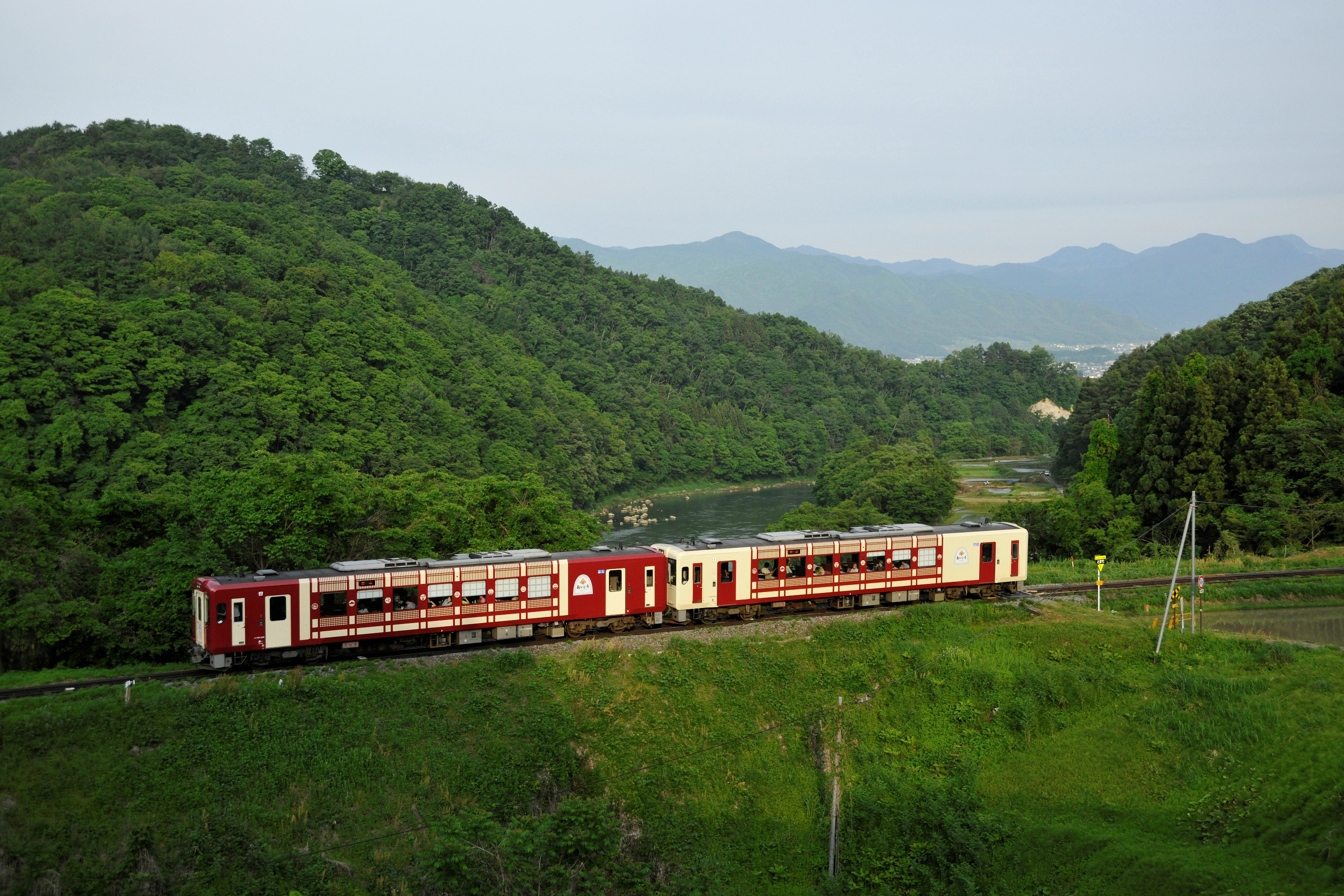
The Oykot running along Nagano’s scenic countryside. (Image credit: JR East)
Getting its name from “Tokyo” spelt backwards, the Oykot (おいこっと Oikotto) is meant to be a contrast to the capital city’s fast-paced lifestyle, offering instead a laid-back and nostalgic ride with an interior meant to resemble your grandmother’s cosy countryside home.

Activities on the Oykot. (Image credit: JR East / Carissa Loh)
At Iiyama Station (飯山駅), take a look at the karakuri clock, featuring mechanised traditional Japanese dolls moving to the tune of “Furusato”, a famous folk song. At Morimiyanohara Station (森宮野原駅), you can see the landmark indicating the highest recorded snowfall ever at a train station in Japan. Along the route, the train offers up-close views of the meandering Chikuma River. The town of Nakano is famous for producing folk singers, and if you’re lucky, there might even be a performance by local volunteers on-board!
The train also runs as “Yuki no Oykot” during the winter months of January and February in 2024.
Read this article for an in-depth, personal experience of a trip on the Oykot.
For more information, check the train’s website here.
⑦ B.B Base: Travel with your bicycle
Routes:
- Uchibo: Ryōgoku Station ↔ Wadaura Station, Tateyama Station ↔ Ryōgoku Station
- Mt. Kano/Saikuru Train: Ryōgoku Station ↔ Kimitsu Station, Kururi Station (transfer at Kisarazu Station), Takeoka Station ↔ Ryōgoku Station
- Sotobo: Ryōgoku Station ↔ Awa-Kamogawa Station
- Sawara/Kashima: Ryōgoku Station ↔ Kashimajingū Station
- Sakura/Choshi: Ryōgoku Station ↔ Chōshi Station

The B.B.BASE travelling around the Boso Peninsula. (Image credit: JR East Chiba Branch)
Short for “BOSO BICYCLE BASE”, the train’s concept is to allow passengers to discover the Boso Peninsula (房総半島 Bōsō hantō) and neighbouring regions by rail and cycling, where they can ride the train and enjoy the splendid views of the peninsula, and continue on a cycling trip after that for more intimate exploration.
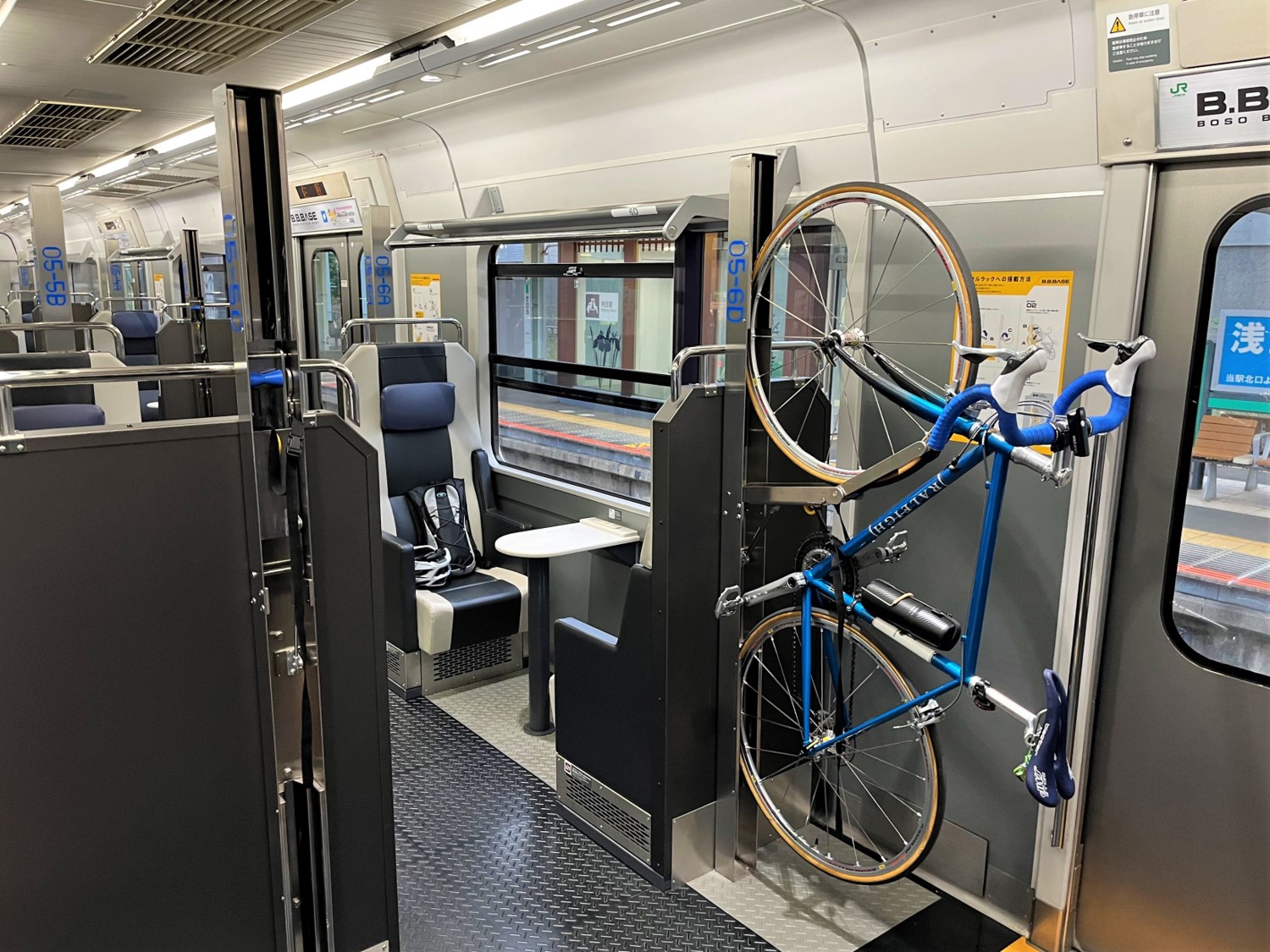
Bicycle racks inside the train. (Image credit: JR East / Kobori)
The train is specially fitted with bicycle racks so that passengers can bring their bicycles with them on board the train and mount them onto the racks safely, allowing them to enjoy the train ride with ease. Those that do not own their own bicycle can also rent one for the start of their journey
For more details on the places you can visit by using the B.B Base, check out the article here.
For more information, check the train’s website here.
Steam locomotive (SL) trains
Treasured relics from the past, these steam locomotives have been restored and repurposed as Joyful Trains.

JR East’s three SL Joyful Trains. (Image credit: JR East)
A big hit amongst railway enthusiasts, SL trains offer a glimpse into the past, and let you live out childhood fantasies of riding a choo-choo train. As they are difficult to maintain due to the large quantities of water and coal used, these trains run less frequently than other Joyful Trains, but can carry more passengers per trip. If you are a train fan, don’t miss the chance to ride them if you can!
⑧ SL Banetsu Monogatari: Enjoy the Ban’etsu West Line
Route: Niitsu Station (新津駅) ↔ Aizu-Wakamatsu Station (会津若松駅) on the Ban’etsu West Line

The SL Banetsu Monogatari in spring. (Image credit: JR East)
Originally built in 1946, the C57 180 SL train was nicknamed Kifujin (貴婦人 noble lady) due to its graceful appearance. The train was pulled out of retirement in 1999 due to popular demand, and was revived as the SL Banetsu Monogatari (SLばんえつ物語). 2019 celebrated the 20th anniversary of this beloved train, and hopefully it will continue to chug along for many more years!

Inside the SL Banetsu Monogatari. (Image credit: JR East / Carissa Loh)
The train’s crimson velvet seat covers and wooden finishes on the armrests, walls and hooks create a nostalgic atmosphere reminiscent of Japan’s beloved Taishō Era (1912–1926). On-board there are also observation spaces, a sales counter, and a play area for children, all of which can be freely used by all passengers.

Photo opportunities are abound on the Ban’etsu West Line. (Image credit: JR East)
The SL Banetsu Monogatari runs on the scenic Ban’etsu West Line, which is known for its beautiful greenery, flowing rivers and photo-taking spots. Many fans prefer to take photos of SL trains, and the Ban’etsu West Line offers some of the best train photography locations.
Read this article for an in-depth, personal experience of a trip on the SL Banetsu Monogatari.
For more information, check the train’s website here.
⑨ SL Gunma: Feel the power of a SL train
Routes:
- SL Gunma Minakami: Takasaki Station (高崎駅) ↔ Minakami Station (水上駅) on the Jōetsu Line
- SL Gunma Yokokawa: Takasaki Station (高崎駅) ↔ Yokokawa Station (横川駅) on the Shin'etsu Main Line

The powerful D51 498 chugging along the Gunma countryside. (Image credit: JR East)
Hardcore SL train fans would know that the most powerful SL trains are the D-series trains, which were used in the past for hauling freight cars. Very rarely would you get a chance to experience riding these, but guess what? One of them, the D51 498, has been repurposed for the SL Gunma (SLぐんま)! Together with the C61 20, these two SL trains take turns to make the SL Gunma’s trips between Takasaki Station and either Minakami Station (SL Gunma Minakami) or Yokokawa Station (SL Gunma Yokokawa).

A fun ride on the SL Gunma. (Image credit: JR East)
If you’re setting off from Takasaki Station, try out a special SL Gunma ekiben (駅弁 lunch box for eating on the train). For the inbound journey, little ones can take commemorative photos in a train driver’s outfit, or experience being a train conductor, even making live announcements on the train!
Read this article to check out what you can experience on a trip onboard the SL Gunma.
For more information, check the train’s website here.
Restaurant trains (with scenic views)

Some of the offerings on the restaurant Joyful Trains. (Image credit: JR East / Carissa Loh)
For foodies seeking a novel train experience, how about taking a trip on one of the three restaurant trains? Joyful Trains in this category offer mouth-watering meals made with locally-produced ingredients, so you can enjoy a good meal while supporting the local farmers at the same time. In addition, these trains also pass by scenic routes, and offer mesmerising views right from the comfort of your seats.
⑩ TOHOKU EMOTION: The fine-dining restaurant train
Route: Hachinohe Station (八戸駅) ↔ Kuji Station (久慈駅) on the Hachinohe Line

Locals welcoming the TOHOKU EMOTION as it passes by. (Image credit: JR East)
The flagship of JR East’s dining trains, the TOHOKU EMOTION (東北エモーション Tо̄hoku Emо̄shon) is a fine-dining restaurant train that incorporates the elements of local and luxury into its dining experience. This train was started in 2013 to support tourism to the Sanriku Coast, which was badly affected by the 2011 Great Eastern Japan Earthquake and Tsunami. Along the journey, it is not uncommon to see locals energetically waving to the train as it passes by.

An experience on the TOHOKU EMOTION. (Image credit: JR East / Akio Kobori (top) and Carissa Loh (bottom))
A journey on this “Tohoku Restaurant Railway” will tantalise your taste buds with locally-produced Tohoku ingredients in all of its carefully thought-out dishes, and delight you with five-star service from the dedicated staff.

Take a ride on this fine-dining restaurant train. (Image credit: JR East / Carissa Loh)
Running along the Sanriku Coast, enjoy unobstructed views of the Pacific Ocean’s cerulean waters from right inside the train. From spring to autumn, you can also get a view of the lush greenery that the train passes by. There is a live kitchen on-board, where you can witness the chefs preparing your meals.
Read this article for an in-depth, personal experience of a trip on the TOHOKU EMOTION.
For more information, check the train’s website here.
⑪ KAIRI: Gastronomic delights from Niigata and Shonai
Route: Niigata Station (新潟駅) ↔ Sakata Station (酒田駅) on the Uetsu Main Line

The KAIRI running along the Sea of Japan. (Image credit: JR East)
Saving one of the best for last, the KAIRI (海里) is the newest Joyful Train in the line-up, and got its name from the beautiful sea (海 kai) and charming countryside villages (里 ri) that are plentiful in the area. This train focuses on the local gastronomy of the Niigata and Shonai Regions, as well as the breathtaking views of the Sea of Japan that it passes by on the Uetsu Main Line.

Interior of the KAIRI. (Image credit: JR East / Carissa Loh)
Unlike the TOHOKU EMOTION, which is a travel package-only restaurant trains, the KAIRI has one dedicated travel package-only dining car (Car 4), while the other cars can be boarded with without packages, ie: with a JR EAST Pass (Nagano, Niigata area).
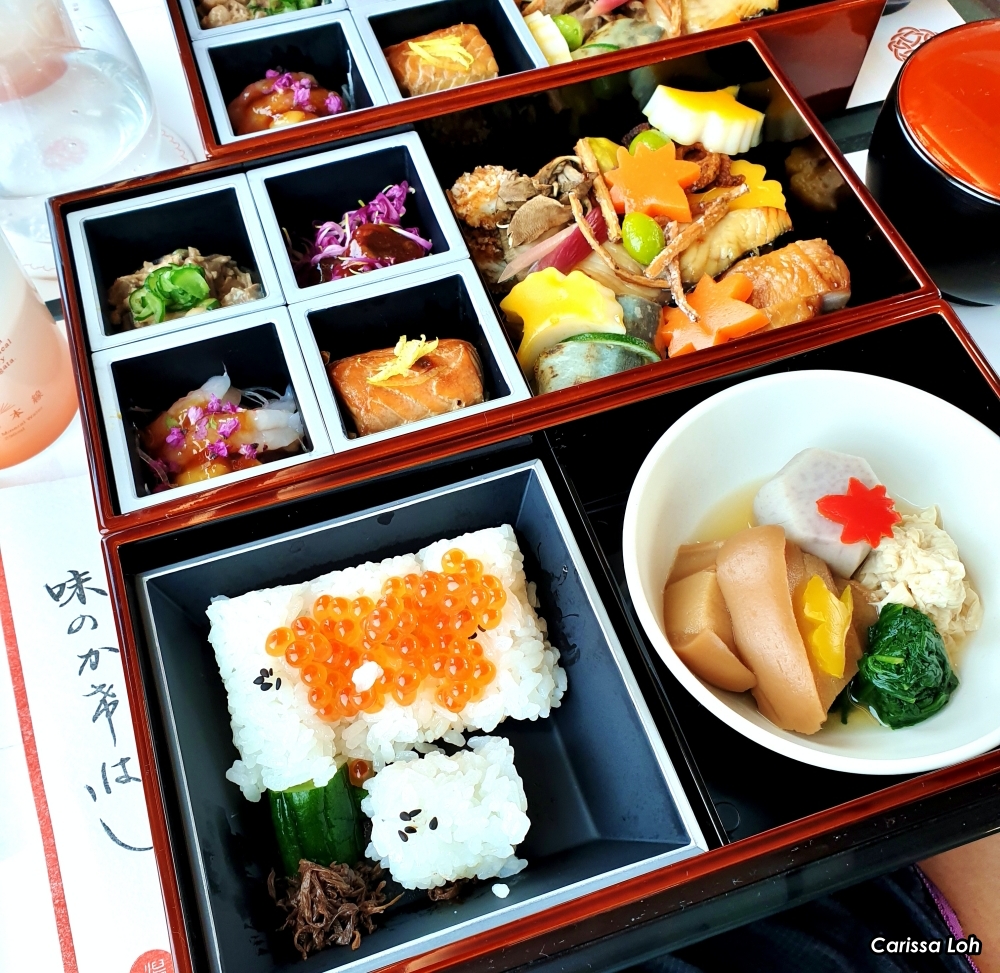
An delightful meal on the KAIRI. (Image credit: JR East / Carissa Loh)
Undoubtedly, most people ride the KAIRI for the gastronomic experience, as the exquisite dishes are sure to tempt your taste buds. Even if you are not riding in Car 4, pre-order bento (弁当 lunch boxes) are available for all passengers who want a taste of what the KAIRI has to offer!
Read this article for an in-depth, personal experience of a trip on the KAIRI.
For more information, check the train’s website here.
How to ride Joyful Trains
If you are thinking of visiting Eastern Japan or riding some of these Joyful Trains, check out the JR EAST PASS. JR East Passes offer substantial discounts on train fares. Foreign passport holders residing in Japan will also be eligible to use the JR EAST PASS (Tohoku area) and JR EAST PASS (Nagano, Niigata area), so you can travel together with your foreign friends and family who are working or studying in Japan.
There are two types of passes, with both offering unlimited rides on JR East lines (including bullet trains and Joyful Trains) in their designated areas for 5 consecutive days. Pass holders can also make seat reservations for Joyful Trains online for free, up to one month in advance, on the JR-EAST Train Reservation.

The JR-EAST Train Reservation. (Image credit: JR East)
JR EAST PASS (Tohoku area)

The new JR EAST PASS (Tohoku area) and usage area. (Image credit: JR East)
If your trip is mostly in the Tohoku Region, check out the JR EAST PASS (Tohoku area). At only ¥30,000, it already covers a round-trip between Tokyo and Morioka (~¥30,020), and with 5 consecutive days of unlimited use available, it is of great value if you ride trains often during that period.
Joyful Trains that can be ridden for free with the JR EAST PASS (Tohoku area):
- HIGH RAIL 1375
- KAIRI (only between Murakami and Sakata)
- POKÉMON with YOU Train
- Resort Shirakami
- SL Banetsu Monogatari (only between Aizu-Wakamatsu and Nozawa)
- SL Gunma
JR EAST PASS (Nagano, Niigata area)
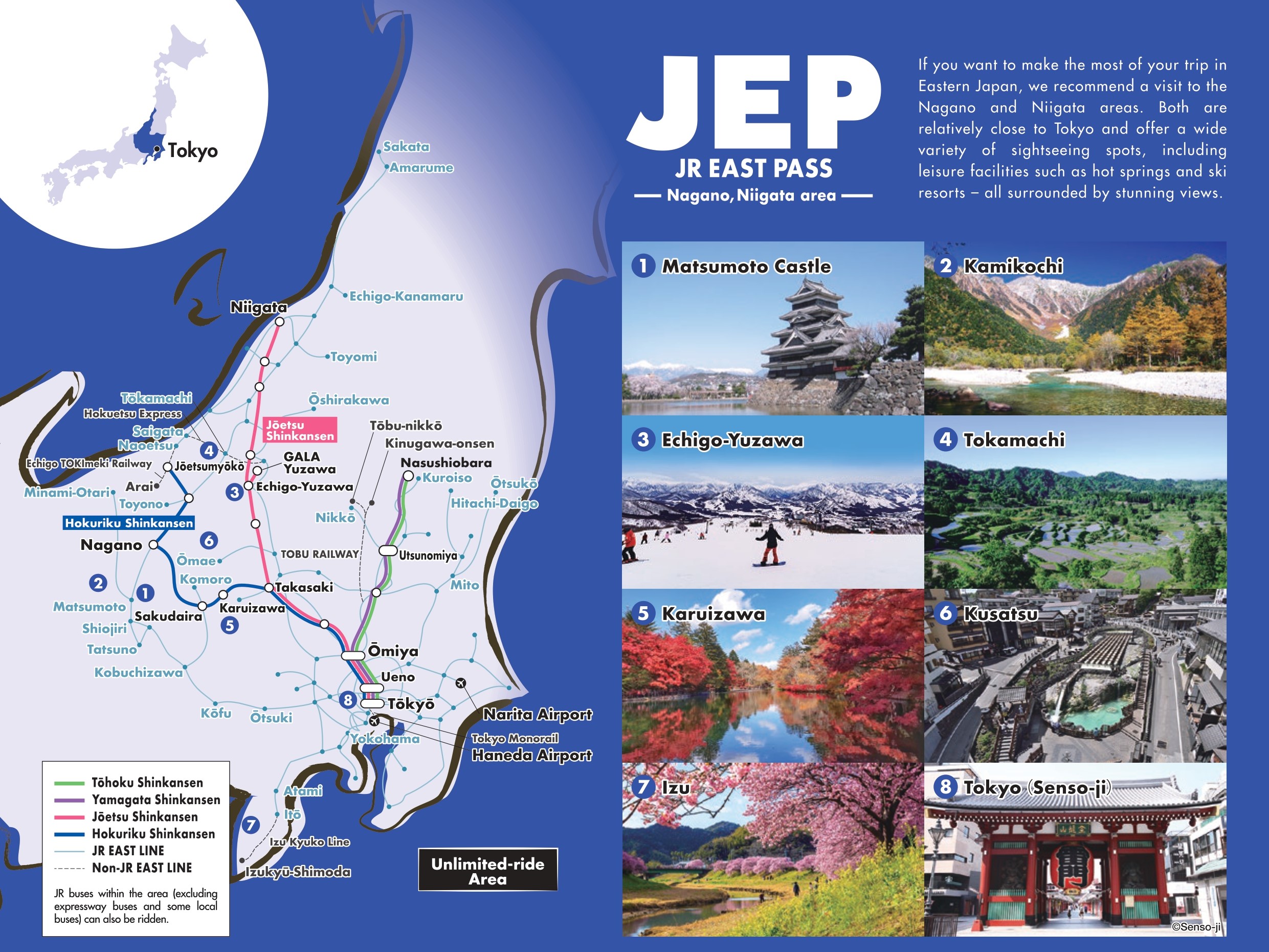
The new JR EAST PASS (Nagano, Niigata area) and usage area. (Image credit: JR East)
If your trip is mostly in Niigata and Nagano, check out the JR EAST PASS (Nagano, Niigata area). At only ¥27,000, it is only slightly more than a round-trip between Tokyo and Niigata (~¥21,000), and cheaper than a return trip to the furthest point covered by the pass between Tokyo and Sakata with a transfer at Niigata (~¥29,080). With 5 consecutive days of unlimited use available, it is of great value if you ride trains often during that period.
Joyful Trains that can be ridden for free with the JR EAST PASS (Nagano, Niigata area):
- HIGH RAIL 1375
- KAIRI
- Koshino Shu*Kura
- Oykot
- Resort View Furusato
- SL Banetsu Monogatari (only between Niitsu and Hideya)
- SL Gunma
Online seat reservations
All Joyful Trains require seat reservations in order to board. JR EAST PASS holders can make seat reservations for the covered trains for free, either online (here) up to 1 month in advance, or in-person after arriving in Japan.
Restaurant train meal packages

Tickets for the FruiTea Fukushima. *Train to be discontinued by December 2023. (Image credit: JR East / Carissa Loh)
For the TOHOKU EMOTION, Car 1 of the Koshino Shu*Kara and Car 4 of the KAIRI, only passengers who have purchased meal packages may board. Even if you have a rail pass, you will not be able to board these trains.
Reservations for meal packages can be made online on the "Joyful Trains Reservation Site" (in Japanese only). Take note that some of the trip dates shown on the calendar are sold by other travel agencies and may not be available for reservation on the site.
Header image credit: JR East




